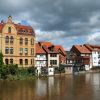Urban versus rural living
Big cities are thriving and villages are dying out? The situation is not quite that simple. Here are some facts and trends about urban and rural living in Germany.

Where does a city end and the countryside begin? It is not always so easy to tell in densely-populated Germany with its 230 inhabitants per square kilometre. 77 percent of people live in cities or urban areas, while only 15 percent live in villages with fewer than 5,000 inhabitants.
“Germany has an urbanised society, and this is also true of rural regions”, says geography professor Ulrike Gerhard of Heidelberg University. “Cities and their surrounding countryside belong together.” Lifestyles differ hardly at all, with commuters travelling in both directions.
Quick facts
Rural exodus and urbanisation
Admittedly, the discrepancy between big city and provincial life in Germany is not as extreme as in other countries thanks to the federal structure with 16 state capitals. An urban/rural imbalance exists nonetheless: while villages close to major cities are thriving, entire regions elsewhere are suffering from a massive rural exodus, especially in the east. It is predicted that some rural districts in the state of Brandenburg could lose almost a third of their populations by 2035.
Such regions suffer from a general lack of jobs, shops, skilled crafts, doctors and banks. Schools and restaurants are closing down. Quality of life is deteriorating for those who do remain, and they have to travel further to access local amenities. Experts warn of a brain drain as it is above all well-educated and mobile young people who are moving away from the provinces.
Equal living conditions
The government now wants to take steps to address the situation. The CDU/CSU and SPD coalition agreement contains the following declaration: “Our goal is to ensure equal living conditions in urban and rural regions, in the east and west.” Small municipalities are to be given more scope for self-administration, improvement of the Internet infrastructure will be driven forward and local economies are to grow. Residents of some villages are taking matters into their own hands and coming up with inventive ideas for making village life attractive and active.
Germany’s most popular cities
Munich, the Bavarian state capital, is considered to be Germany’s most liveable city. Apart from the major cities, it is above all medium-sized towns and cities that are seeing their populations grow. The current climbers are Fürth, Bamberg and Passau in the south, and Chemnitz, Magdeburg, Schwerin and Erfurt in the east of Germany. They are attractive for their educational institutions, modern jobs, cultural and leisure activities and comparatively low rents.
Although the great majority of Germans live in cities, 44 percent dream of a life in the countryside. That was the finding of a representative survey conducted by TV channel ZDF for its programme “Die große Deutschland-Studie“ (i.e. The Big Germany Study).
Studies and links relating to urban and rural living in Germany
Bertelsmann study: small and medium-sized cities are in vogue
Interactive map: population development in Germany
Demography portal of the federal and state governments
“Die Zeit”: Diving into Urban-Rural Prejudice
Mercer study: Quality of Living City Ranking 2018
